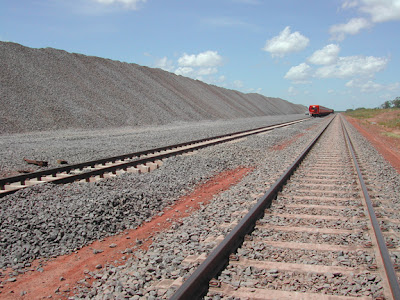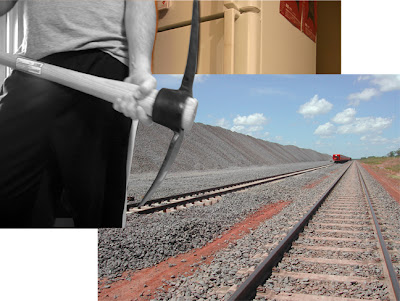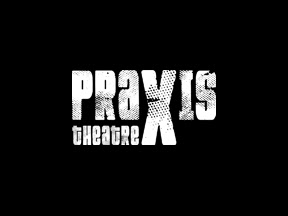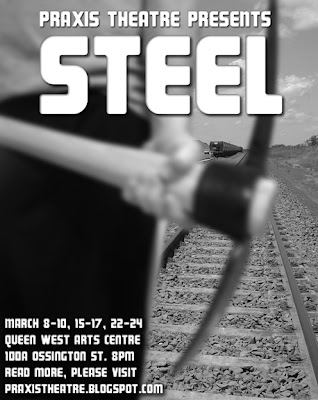Category: The Steel diaries
 It’s a one-man show, don’t fuck it up
It’s a one-man show, don’t fuck it up
By James Murray
With Praxis Theatre’s one-man show Steel in the final leg of its three-week run, actor James Murray reflects on the production so far:
The day before the show starts
After a gruelling three months of rehearsals, our pre-show tech/dress rehearsal is an unmitigated disaster. This is understandable since we haven’t yet run the show with full transitions, light and sound cues. The problem is that we have to open the next evening and there is no time for another tech rehearsal. Director Mike Wheeler arranges for us to do a ‘tech-less’ run-through the next afternoon, before opening, because, he says, all of those cues have hindered my performance.
The final and imperative acting notes are: “slow it down”, “talk to the audience” and “become more intimate with them and all those imaginary characters you speak to throughout the play.”
Opening night
At 7:45 pm on opening night, I wait in the office while stage manager Meredith Scott leads the audience to their seats. My stomach is in knots. I have to urinate for the umpteenth time and I’m trying to dispel my fear through long, deep breaths.
My three main worries are formidable and intrusive:
1) Will I remember those 22 pages of dialogue? Word for word?
2) Wow, those transitions are insane! I have to remember them, too?
3) Oh God, I have no water! No access to water during the entire show. I’m going to be T.E. Lawrence crossing the Nefud Desert by the third scene.
Thankfully, opening night brings the most supportive and loving audience any actor could ask for – the show goes way better than I thought it would. There’s a nice reception at “Sparrow”, the bar next to the theatre, and I’m really looking forward to seeing my family when the come to see the show the next evening. Although we feel that tonight’s performance made a decent impact, there is a big notes session the next day. It can be better.
Director’s notes
When it comes to breaking down this show’s first performance, Wheeler pulls no punches. My eye-line was locked over the audience’s heads, he says, and I kept pacing three steps from stage right to left throughout the narratives. Distracting.
“The play looked like a series of monologues”, Mike says. “You need to play off of the audience. You need to look right at them and include them more. Think of them as very intelligent children sitting around a campfire except they don’t know you or trust you yet. You need to win them over.”
He’s right. A one-man show is a lonely stage – there isn’t anyone to play with up there so why not use the people who are sitting just seven feet
“I don’t just need to break through the forth wall, I need to destroy it.”
away from me? This is one of the last bolts that needs to be tightened. I don’t just need to break through the fourth wall, I need to destroy it. It brings on a whole new challenge, but it makes the build-ups and peaks more compelling. Also, I definitely needed to make the conversations with the imaginary characters more specific and engaging.
 The playwright’s parents are in the audience
The playwright’s parents are in the audience
My most important performance was the night playwright Andrew Zadel’s parents came to see the show. Mrs. Zadel gave me a much-appreciated standing ovation. When I met them after the show, I was overwhelmed by how much this production had meant to them and how proud they were of their courageous and talented son Andrew. I could barely hold back my tears and I’ve never received such a priceless compliment.
There’s only one thing I want to say: Andrew, my friend: when the show closes this Saturday, Steel will not be buried six feet under, nor will it be swept under the bed. Steel is going to have a siesta under a golden day of blue sky and sunshine until the time is right to unleash its power again. Fire awaits.
Be sure to catch James Murray in Praxis Theatre’s Steel this Thursday, March 22 through Saturday, March 24 at the Queen West Arts Centre, 100A Ossington Avenue, Toronto, Canada. Click here for a map. Tickets at the door.
 49 hours to opening curtain
49 hours to opening curtain
By Ian Mackenzie
I’m filing this dispatch on behalf of the creative team, which is – as you’ll see – hard at work putting the finishing touches on our play Steel.
There is much to be excited about: the newly established Queen West Arts Centre; Andrew Zadel’s original script; Michael Wheeler’s vision for the play. And yet, as I write this, the 49 hours we had has become a mere 46, less than two days. I can only imagine that the weight of the opening curtain hangs heavily on these theatre artists.
What follows is a short photo easy chronicling a window in this production’s history: 49 hours to opening curtain.
 The venue. Queen West Arts Centre.
The venue. Queen West Arts Centre.
 The space. Looking back toward the entrance of the black box.
The space. Looking back toward the entrance of the black box.
 Director Michael Wheeler.
Director Michael Wheeler.
 A director’s notebook.
A director’s notebook.
 Stage Manager Meredith Scott and a LITEPAK lighting console.
Stage Manager Meredith Scott and a LITEPAK lighting console.

Lighting designer Paul Hardy.
 House lights.
House lights.
 David Galpern and Steel’s James Murray.
David Galpern and Steel’s James Murray.

Backstage, looking through blacks that were hung earlier in the day.
 Someone else’s tool kit.
Someone else’s tool kit.
 Three lights.
Three lights.
 Steel opens this Thursday, March 8 @ 8pm at the Queen West Arts Centre. Tickets at the door.
Steel opens this Thursday, March 8 @ 8pm at the Queen West Arts Centre. Tickets at the door.
 The legend of Mafu Jiang
The legend of Mafu Jiang
By Ian Mackenzie
Last time we spoke, I gave you probably more information than you needed on Steel’s print marketing strategy: you may recall the pickaxe, the Stranger Theatre ad, the half-baked Photoshop humour.
Since then, we’ve developed our final publicity materials for the show. No real drama to report on that front. After all, if we’ve done our job, those posters and postcards should be speaking for themselves (or, more accurately, speaking for our show).
The big news is the discovery of Mafu Jiang. He’s an independent printer trained and equipped in the ancient art of high-quality digital printing. We used him to print our publicity materials for this show. His prices are incredible, and his quality is top notch.
1000 postcards (two-sided colour) for $200.
100 posters on high-quality glossy stock for $60.
Anyone who’s grown tired of the Kinkos manoeuvre or of similarly high-priced print options, you need to write this information down – talk to Mafu Jiang.
Here’s the info:
mafu_jiang@yahoo.com
416 303 3214
Located near Lansdowne & Dundas in Toronto
An independent printer for the independent theatre. What’s not to love?
 An actor’s 30-hour research bender
An actor’s 30-hour research bender
By James Murray
 The question is this: As the sole performer in Praxis Theatre’s upcoming rail-inspired play Steel, how can I learn the requisite Canadian rail history without having to sift through Pierre Berton’s 496-page rail primer The Last Spike?
The question is this: As the sole performer in Praxis Theatre’s upcoming rail-inspired play Steel, how can I learn the requisite Canadian rail history without having to sift through Pierre Berton’s 496-page rail primer The Last Spike?
I’ve been listening to Gordon Lightfoot’s Canadian Railroad Trilogy, but I’m afraid that only serves as a small dose of inspiration. Clearly, I need a more adventurous research project.
Uncle Ridsy
With that in mind, I called Derek Ridsdale – an old Ottawa Valley high school chum. (Those in the know call him “Uncle Ridsy”. It’s an inside joke, and only a marginally funny one at that. Take it or leave it.)
These days Uncle Ridsy is based in London, Ontario, and has been working for Canadian Pacific Railway for 13 years. His family are fourth-generation railway workers. Coincidentally, one of the characters I play in Steel, George, is a fourth-generation steel worker – “making history with 10,000 tons of steel.” As it turns out, the semi-fictional George and the very real Uncle Ridsy have much in common.
Here’s another charcteristic they share: when Uncle Ridsy’s name comes up in discussions among friends, his charismatic and energetic storytelling ability is the gravitas around which our reminisces orbit. When he has a tale that sufficiently excites his interest, Uncle Ridsy is prone to standing up and waving his arms wildly in the air, acting out each nuance of his story. Steel‘s George has been written with a similar delivery in mind.
This parallel and divine coincidence provided an amazing opportunity for me. So I phoned him up: “Uncle Ridsy? It’s Jimmy Murray!”
“I’m doing research for a role. Can I come see you in London so you can tell me stories about the railroad? Please. Uncle Ridsy?”
His response: “Sure buddy! C’mon out fuck! I’ll tell ya everything ya need to fuckin’ know fuck! I’ll take ya out to the yard, put a maul in yer hand, you can drive all the fuckin’ spikes ya want!”
So I did.
Booze and steaks
I meet Uncle Ridsy at Yorkdale Mall in north Toronto for lunch at The Pickle Barrel. We both order ruben sandwiches. His wife, Melissa happens to be working in the Greater Toronto Area that day so she picks us up.
It’s a pleasant 90-minute drive from Toronto to London, with the music of “Guided By Voices” and “Tapes ’n Tapes” playing loudly in the background – a view of sunshine reflecting off the snowbanks and frozen trees. I fall asleep.
I awake in the parking lot of a liquor store in downtown London. Uncle Ridsy is slapping my knee.
“We need booze and steaks!” he says.
We obtain the provisions and head out to their cozy, suburban home. He calls it ‘The Ranch’. I receive a warm welcome from Jack and Charlie – a chihuahua-maltese mutt and a well-fed tabby cat, respectively.
Uncle Risdy gives me a quick tour of the house before we get down to business with the tunes, the Tuborg and the steaks.
I pull out my photocopy of the Steel script and my Praxis Theatre notebook.
 How to derail a train
How to derail a train
“First things first,” I say, “what’s a section gang?”
Uncle Ridsy begins: “Yeah, yeah . . . they’re the nuts, bolts and rail boys. The train can damage the track at any time, eh? So they send the gang out to repair it.”
That is, out to repair that particular ‘section’ of track . . . hence the name “section” gangs.
“How do they repair the track and what tools do they use?”
Temperature, apparently, is the problem.
When the temperature drops to -30°C during our harsh Canadian winters, the rails shrink and the nuts, bolts and spikes can fly out, explains Uncle Ridsy. In the summer, when it gets as hot as +30°C, the rail can be damaged by heat kinks, which can derail a train. No problem, he says, the section gangs use specialty tools like track jacks, track wrenches, spike mauls and tamping bars.
This technical line of inquiry goes on for some time. My questions and his answers becoming more arbitrary as one topic leads to the next.
Wow. Did I ever not know anything about how the railroad works.
Under the volcano
He fills me in about the track bed and how it used to be made of molten lava, which is apparently really harmful to the environment. Now they use chipped limestone they get from a plant up in Beachville, Ontario.
We cover the yard crews, which consist of a brake man, a conductor and an engineer. Uncle Ridsy goes off on a tirade about how one guy can put a mile-long train together by himself using a remote control beltpac.
I learn about the different types of cars: hoppers, flatbeds and gondolas. We even stage a scene from the play so I can understand the basic physics behind how the cars actually attach: the big metal hooks are called ‘couplings’ and when they attach, they call it the ‘knuckle’.
The more I ask him to specify, the more I get out of him.
What the fuck is an S&C box?
The biggest challenge comes when he tries to elucidate the systematic procedures of the ‘Signals and Communications Dept.’ or S&C box, which is his current placement. He is a signalman, stationed in a small box or bungalow somewhere along the endless miles of track. The S&C box stores a multitude of current relays, a rectifier that converts alternate current (AC) to direct current (DC) and a bank of batteries.
It took Ridsy almost 13 years to learn how to operate this highly sophisticated control system, forgive me if I can’t go too deeply into it here.
Uncle Ridsy and the poem
My next set of questions pertain specifically to excerpts from the script. For this to work, poor Ridsy has to interpret the script’s poetic description of the signalman job:
“I tried to write freelance but they offered me steady money, tied to the nexus of ten thousand steel roads, calibrating signals: it’s a little glass box with a solenoid coil and when you run a current through it, it pushes against a spring and makes a connection: electric violence, caged, a thunderbolt bent double.”
Boy do we ever sweat with this one. Uncle Ridsy fights like a pitbull trying to decipher this poem and the whole system for me. He’s madly scribbling diagrams all over my notebook and his phone bill. When we finally reach a slight level of satisfaction, he says, “Steak’s ready!”
We eat, drink, listen to some more fine music then cab down to Scott’s Corner Pub for a nightcap.
A broken knuckle
The next day Ridsy takes me on a all-access tour of the railyard.
I’m playing with all these 25 lb. tools and get a tour of an actual S&C box, at which point Uncle Ridsy gets all worked up again trying to explain the details of the various switches and levers. Then he shows me the car attachment devices: the coupling, hot shot and knuckle. It makes me think of a particularly grisly scene from the play . . . holy shit!
As we’re driving out, I see a broken knuckle on the ground.
“Stop,” I say, “I wanna grab that. That’d be perfect for the set!”
“Dude, it’ll rip through my fuckin’ car!” Uncle Ridsy says. “Weighs about 400 lb.!”
Are you on the bus or are you off the bus?
Ridsdale, Melissa and I top off the trip with dinner at a Vietnamese-Thai fusion place. I climb on the 8:30 pm Greyhound with a belly full of pad thai and pass out. It was 30 hours well spent.
As an actor trying to understand the inner workings of the Canadian rail system for a part, this trip to London helped immensely. It gives me insight into what the characters in the play are talking about and what they’re going through.
I’m sure Andrew Zadel would have been happy to fill in the blanks, but – you’ve heard – our playwright’s in the Congo.
Andrew. Come back. Your play misses you.
 How to write a play
How to write a play
By Andrew Zadel
Some guy once said, “I am not a writer except when I write”. So, according to that guy, I have not been a writer for quite some time, but instead am just a stodgy international civil servant with a profound, unshakeable and yet completely uninspiring sense of self-loathing. And I trust that guy – whoever the fuck he is. He seems to know a lot about me.
My psychic told me that in a former life I was a playwright and musician in Montreal. But now I work for the UN in The Democratic (and hot) Republic of Congo, right on the Rwandan border. In the last two months the area has seen a major volcanic eruption, massive rebel military advances with concomitant thievery and sexual violence, and the displacement of 100,000 people.
I have written all about it: daily reports, weekly reports, monthly reports . . . it’s kind of like being a secretary in hell. Lots of reports. No play. Ever seen The Shining?
Anyway, despite the Sisyphean office purgatory that actually briefly robbed me of my ability to walk due to the complete atrophying of my back muscles, no one can dispute the fact that I wrote this play called Steel that is going to be performed in Toronto in March by the handsome and talented James Murray.
Other than that, my only connection to the Toronto arts scene is my obsessive and repetitive consumption of the latest offerings of all-girl power trio Magenta Lane. If I can convince the drummer to go see the play, it will be almost like being “on the scene” – in a 21st century “I have given my body to the Internet” kind of way.
This social amputation is almost fitting, however, given that Steel was always written in isolation. The first round was staring out the window of a VIA train from Vancouver to Toronto. The landscape made it onto the paper, but there was hardly a play there.
Luckily, as some kind of slow-burning investment, my dad had bought a condo in the marshy retirement community of Alexandria, Ontario. I locked myself in there for a week with five boxes of cereal, a book about turn-of-the-century railway work gangs, and somebody’s PhD thesis about tourism on the Queen Charlotte Islands. I forbade myself from walking over to the Tim Horton’s, lest I lose a day or two hanging out with bored rural high school kids. My only human contact was listening one night to someone screaming and sobbing violently outside the neighbouring hospital.
So, as planned, I was left with no other options and I wrote. And I wrote and I read and I wrote some more. And then I deleted, and I deleted some more. Art is communication, and I was stuck talking to myself in an unfinished apartment overlooking a Canada geese breeding ground. If you press the delete key often enough, you can even erase the words from inside your stomach.
So the play got written, but only after I made it back to my fellow human beings. There is definitely a small part of my soul that was eaten by Alexandria, Ontario. But at least it seems to have been spat back into the text: the grandfather I knew only as a pair of calloused hands offering me bubblegum, the raw and unfinished country I have wandered from time to time, the eight-foot beams I stacked under summer sun in a Montreal rail yard . . .
I guess that’s why people like this play – because it is about all of us. It’s about getting out of bed every day and doing shit that you don’t want to do, because people expect things from you and you’re standing there staring at a table with no bread on it. You gotta do what you gotta do. You can’t just pack it all in and be a playwright. right?
Okay, back to work. Reports to be written. Somebody eat a snowflake for me.
 It’s a pickaxe, stupid
It’s a pickaxe, stupid
By Ian Mackenzie
Your regular Steel diaries correspondent, Michael Wheeler, has kindly allowed me to hijack this week’s post in order to bring you a message from the front lines of the show’s marketing campaign.
It’s a message that involves 12 image files (including the intro shot, above) and judicious use of the word “PhotoShopped”. Mostly, this entry into the Steel diaries is about process, which makes it right at home among Michael’s other entries.
The challenge
As part of our marketing strategy for Steel, we’ve arranged to place ads for our show in the programs of a couple of other productions. The nice people at Stranger Theatre, for example, agreed to run a Steel ad in their and what Alice found there program. But since we’re still a few months away from our show’s March run, we hadn’t yet given a lot of thought to the design of our promotional poster and postcard, nor do we have a graphic designer on board to help with such endeavors.
So, with limited resources we set out to build the ad ourselves. The upside is quick turnaround. The downside is diminished quality and limited expertise.
The iconography
We knew, from marketing a previous workshop version of the show, that the pickaxe was a strong icon to work with.
 Promotional shot from an earlier production of Steel.
Promotional shot from an earlier production of Steel.
The pickaxe relates nicely to the content of the play, and it’s also a strong visual motif.
 Another promotional image from an earlier production of Steel.
Another promotional image from an earlier production of Steel.
(Steel playwright Andrew Zadel with pickaxe.)
Instead of trying to reinvent the wheel for this latest incarnation of the show, we agreed to keep working with the pickaxe image.
This is our new pickaxe:
 Pickaxe from ML Lumber & Building Supply: $31.16
Pickaxe from ML Lumber & Building Supply: $31.16Putting it together
We started with this hastily taken image:
 Scary.
Scary. To soften the impact of the aggressive-looking pickaxe and to contextualize it with the railroad, we pulled this image off the Internet:
 We don’t own the rights to this image.
We don’t own the rights to this image.
We “PhotoShopped” the two images together . . .
 . . . stripped out the colour and cropped the image to the ad’s specifications (3.9 x 4.9).
. . . stripped out the colour and cropped the image to the ad’s specifications (3.9 x 4.9).

We tried to include our logo, but given the composition of this ad, we would have had to run the logo in reverse (i.e., white logo on black background).
 It just looks muddy.
It just looks muddy. Because of the distressed treatment of the type, our logo doesn’t look good when reproduced in reverse in small scale. (For more info on our logo, please feel free to check out our logo’s usages guidelines here.) And while we don’t like the idea of running an ad without our logo on it, we made the executive decision to leave it out of this piece.
Finally, we added our text.
You’ll notice that we’ve applied a blur effect to the figure in the foreground.
No masterpiece, but it gets the job done.
With only minutes to spare on our deadline, we sent it off to our contact at Stranger Theatre only to discover we’d built the ad to the wrong orientation.
Here’s the recut, landscape-oriented version:
 Landscape orientation allowed us more room to use our logo.
Landscape orientation allowed us more room to use our logo.The ad saw its first light of day at the premier of Stanger Theatre’s and what Alice found there.
 Here’s the final ad in Stranger Theatre’s program.
Here’s the final ad in Stranger Theatre’s program.
Much thanks to Kate Cayley and Lea Ambros for the great back cover placement!
(BTW, and what Alice found there runs until February 4. Check it out if you can.)
Seeing our ad hard at work at the premier of Stanger Theatre
’s show reinforced for us the power of swapping program ads. Our show is still a couple of months away, but getting the word out early, and often, can only increase the show
’s profile and support us when we arrive at the difficult task of getting those proverbial bums in seats.
Lessons learned
1. Decide on and stick with a consistent visual motif.
2. Always verify your ad’s orientation (landscape or portrait) before you start.
3. Make sure to include your logo in your ad.
4. Ad swapping is a great way to dramatically increase media impressions.
5. Use the word “PhotoShopped” sparingly.
This is only a prototype
We’re hoping this initial foray into Steel’s marketing campaign will provide the inspiration for a more professional execution as we draw closer to the show.
I like the basic idea and composition used here. I think we may be able to find a more suitable typeface, develop a colour version, use our actor, James Murray, as the model, find a solution to our logo woes, and generally tweak the layout.
If you’re in Toronto over the next few months and happen to see a poster or program ad with a pickaxe on it, please think of us and our show and these beginnings to our marketing campaign.
 The playwright’s in the Congo, the theatre’s in the alley
The playwright’s in the Congo, the theatre’s in the alley
By Michael Wheeler
The really friggin’ fantastic news is that we know when and where the show will be going on:
March 8th-10th, 15th-17th and 22nd-24th
The Queen West Arts Centre – 100A Ossington St.
(It’s just north of Queen Street)
All shows at 8pm
How did all of this come about, you ask?
Well Dave Galpern, who works with The Classical Theatre Project and The Toronto Youth Theatre, is an old friend. We did shows together at Montreal’s McGill Universtiy in the 90s and he played Koroviev in the Praxis Theatre production of The Master and Margarita.
His space on Ossington has thus far been used as a rehearsal centre for his two companies before their shows open at the Young Centre, Hart House . . . what have you. The thing is, the largest of these rehearsal spaces would also make a great, I mean really fabulous, theatre. It should have its own name. It is yet to be named. High ceilings, lots of room, obviously its proximity to all the shit going on down on Queen West makes for a pretty great location, too. So we made a deal and that’s where Steel will go on.
Now the tricky part is, there isn’t anything else to work with. So, we have two projects now:
1) putting a play together; and
2) putting a theatre together.
Should be no problem. Oh wait – we have no money and very limited free time. Could be a problem. Will definitely be interesting regardless.
Anyone reading along who has access to lights, blacks or chairs should be in contact at this point. Please. We have free program ad space, multiple tickets, and our undying gratitude and appreciation to offer.
Have I mentioned that the playwright is somewhere in the jungles of the Congo reporting on human rights violations for the UN? I wonder how those rewrites are going?
Tomorrow is our first official rehearsal. We aim to have a strong grasp of what the F we are up to by the end of the month so we can put the whole thing together with vigour in February. Rehearsals are, of course, in Jimmy’s living room. This is one of the benefits of the one-man show.
On the creative end of things, the team had a long discussion the other night about whether or not we need a set designer. We didn’t get anywhere.
Maybe once we have a better idea of our resources and approach this time around, we’ll know whether we’re in over our heads in this element or not.
And publicity, oh publicity. What are the myriad of ways we can get people, and reviewers, whose reviews would bring more people out to see this one-man show at a venue nobody has heard of that we just invented? Publicity could have its own blog. But that may be too meta-narrative. We’d have to start a blog about having a blog.
But we do have a place . . . and a date . . . and an actor . . . and a script . . . so hey, the rest is just details, right?
 A two-minute test beacon
A two-minute test beacon
By Michael Wheeler
Steel is moving along at the speed of molasses, but the blog waits for no man, so I soldier onwards.
The most positive Steel-related news was that we presented a short section of it at a fundraiser for Stranger Theatre last Friday and it went over really well. It was encouraging to send a two-minute test beacon out there and be reminded that: a) people like the material; and b) James Murray is a compelling actor. Good work Jimmy. Before I was excited – now I’m psyched.
We had a good rehearsal to put that section together, too. One-man shows are kinda crazy for the actor. There’s no one else there for them to deal with – no objectives to achieve based on someone else’s behaviour. It requires more imagination, more storytelling, more admitting that the audience is indeed there in the room with you.
We’re still trying to figure out where the show will go on. There are promising developments with a space we will be seeing in the next couple of days . . . we shall see.
There has also been some good news on the fundraiser front. We’ve found a space! But I will leave it to Praxis Theatre’s Associate Artistic Director, Simon Rice, to flesh out the details for you at a later date.
Am also musing on how to generate free publicity for our show. We have a very limited budget. If you’re working with a theatre company and have anything opening between now and March, we’d love to have a little thing about Steel in your program. We will obviously do the same for you. It costs virtually nothing and every person who sees it already goes to the theatre. It’s a good deal for everyone all around.
I’m having breakfast with Andrew Zadel (the playwright behind Steel) tomorrow as he passes through the t dot. With any luck, I’ll be able to convince him to contribute to our next Steel blog entry.
Stay tuned.
 Prologue
Prologue
By Michael Wheeler
Okay so Praxis is remounting Steel. It’s a one-man show that connects a Haida teenager, a failed poet and a racecar enthusiast through the Canadian railroad. We first mounted it two years ago and it did phenomenally well. It was Runner-Up for Best Text at the Montreal Fringe and then won the Producer’s Pick and Best Independent Production at the London, ON Fringe. Eventually we brought it to the t. dot for a weekend and rigged up a workshop production we presented on the back patio of Ted’s Collision. Remember, that was a workshop production; ’cause the version we’re doing now is the, wait for it, Toronto Premiere (thank you Chris Reynolds).
The original version was also performed by the playwright, the multi-talented Andrew Zadel. Andrew, selfish bastard that he is, seems to think that his work as a human rights monitor for the U.N. in the Congo should take precedence over Canadian independent theatre projects these days. Thus, the role has been recast with the Robert Downey Jr-esque James Murray (hey that’s not me, it’s eye magazine). I will be directing it again and Simon Rice joins the production as Assistant Director.
So, we are at the early stages of figuring out how this will work. We know we want to put it on in March. We know we don’t need a large venue, maybe 40 seats. We have looked at a bunch of spaces, but none of the good ones have returned our phone calls. I am looking at a new space on Ossington tomorrow, with our lighting designer, Paul Hardy. I’m hoping it will do the trick. Anyone reading this with suggestions in this regard, feel free to leave us a post.
We’re going to continue with these blogs as the production progresses. This is the boring one that you need to read to get the background and everything. Let’s call it a prologue. Catch further entries that are sure to be full of bon mots about funny things that happened in rehearsal and arguments about what the poster should look like and all the other mundane things that go into a show that I hope to rehabilitate with my propensity for witty prose. I am purposefully throwing humility to the wind here in an effort to get someone ANYONE to start leaving posts about this thing, even if it’s just to chop my ego down to size. More to follow. Stay tuned.
 It’s a one-man show, don’t fuck it up
It’s a one-man show, don’t fuck it up The playwright’s parents are in the audience
The playwright’s parents are in the audience





























Recent Comments